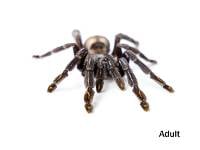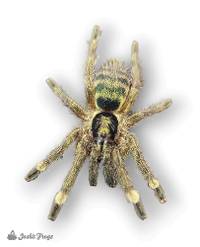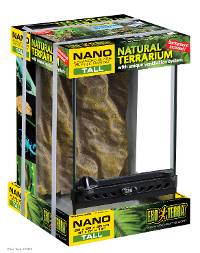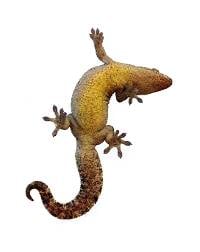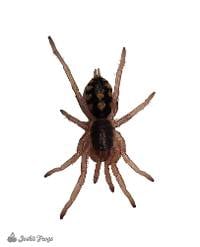Josh's Frogs
Gooty Sapphire Ornamental Tarantula - Poecilotheria metallica | 2 inch (Captive Bred)
Gooty Sapphire Ornamental Tarantula - Poecilotheria metallica | 2 inch (Captive Bred)
$119.99 5.0 out of 5 stars
(1)
5.0 out of 5 stars
(1)About This Product
Environmental Caution:
When a damp environment has too little air circulation, this can lead to an anaerobic environment. Where the typical aerobic bacteria helps keep certain types of waste from building up, they are instead replaced by anaerobic bacteria whose waste is more likely to be toxic and harmful. This is often accompanied by a strong swampy smell.
To guard against anaerobic environments, it is important to monitor and control moisture in the environment as well as air quality. One way to maximize both is to have plentiful live plants as the byproduct of photosynthesis is oxygen and water. Springtails can help keep the substrate aerated and break down waste so that the beneficial bacteria can more easily turn it into plant food.
This species has medically significant venom, bites in some circumstances could require medical attention!
Defining Characteristics:
- An iconic spider for both its patterning and blue coloration, this species is a treat to catch out of its hide
- Although this species is so incredibly colorful, it blends in in its natural environment
- Bright yellow “flash colors” on the underside of its back legs warn predators that it is venomous
- This species has been known to live communally under very specific living conditions
Name: Poecilotheria metallica is commonly known as the Gooty Sapphire Ornamental Tarantula. The scientific name has Greek and Latin roots meaning “colored”, “beast”, and “metallic”.
Recommended Enclosure Size & Setup: Poecilotheria metallica is an arboreal species, meaning the enclosure should be taller than it is long. The recommended enclosure height is at least 3 times the spider’s diagonal leg span, and the other dimensions should not be less than 2 times the spider’s diagonal leg span. The enclosure will need to be upgraded as the animal continues to grow.
4-5 inches of substrate will help the terrarium retain humidity while still allowing for this species to have its high ventilation requirements. ABG mix, coco cradle, or Dig-It are good substrate options, but our Pet Bug Team prefers ABG all the way!
They will benefit from a variety of terrarium furniture to climb on and foliage to hide behind. Live plants can be beneficial to air quality.
Temperature (°F): This species thrives in the mid 70s to low 80s, so a temperature close to 80° is ideal. Temperatures regularly dipping below 65 or spiking above 85 degrees should be avoided.
A reliable thermometer should be used to monitor temperature.
Humidity: These spiders thrive in a humid environment, so the recommended ambient humidity should stay between 60 and 75%. This can be achieved by making sure the substrate is always at least slightly moistened. Depending on your location, you may need tools such as a humidifier to achieve this environment.
The enclosure sides and décor should be spritzed at least lightly around twice a week to provide your animal droplets to drink from and keep humidity up. Do not spray your spider directly.
A hygrometer is a great way to monitor the humidity for your animal and see any needed adjustments.
Size: At the time of sale, this animal will be at least 2 inches. Females can grow to be up to 8 inches, and typically the males are a bit smaller. We measure our spiders using diagonal leg span.
Lifespan:
Feeding: These spiders are currently eating two to three 1/2 inch crickets, once a week. There are a variety of appropriate prey items that you can offer, such as roaches, waxworms, black soldier fly larvae, hornworms, and silkworms. Consider feeding your prey items with our gutload formula to give your pet well-rounded nutrition.
We recommend that the prey items not be much longer than the tarantula's “head” is wide. Larvae are an exception—our larvae are harmless. Since they are very high in fat, they're not the best staple diet, however they make a great weight gain supplement.
Remove uneaten prey items after 24 hours, these may stress your animal out or endanger the spider during molting. Never attempt to feed a freshly molted tarantula less than a week after their molt to prevent injury to the spider. Depending on its age, the hardening process could take anywhere from 48 hours all the way up to a week.
Sexing: Poecilotheria metallica sold by Josh’s Frogs are unsexed.
Color/Pattern: As spiderlings they are largely grayscale in color, with some start to their adult patterning even as babies. As they mature, their colors will change to primarily blue, black and white on the top, with the underside of their legs having bright canary yellow bands.
Social Behavior: Poecilotheria metallica can be kept communally under the right conditions. Unfortunately, if anything goes wrong, they may harm or even kill each other.
This species spends its days hiding on the underside of cork bark. They often explore their habitats at night.
These tarantulas have very potent venom, bad urticating hairs, and are quick to react defensively.
Natural Range: Poecilotheria metallica in the wild can only be found in a 100 square kilometer area in central southern India called Andhra Pradesh. Pocock initially discovered them in Gooty, but it has since been concluded that the specimen he found there was only there by accident.
History in the Hobby: When Poiecilotheria metallica entered the hobby almost 20 years ago, 3/4 inch babies were selling for $350!!
Links of Interest:
- Arachnoboards: A community of spider enthusiasts that will be able to or have already answered almost any question you can think of with regards to tarantulas.
Shipping
After placing an order containing a live animal, you will receive a scheduling email containing our JotForm scheduling link to schedule your new pet's delivery date.
With this scheduling link, you will be able to schedule your order's delivery up to 30 days in advance. You will be able to choose a date of delivery for Tuesday-Saturday (Saturday arrival depends on the carrier's service availability) with the estimated time of arrival generally being 12pm, or 4:30pm for more rural areas. Overnight lows must be above 40°F to ship directly to you (or above 30°F for FedEx Ship Center pickups) as well as below 90°F by estimated time of arrival.
If you require further assistance, or prefer to talk to one of our Customer Service agents, please feel free to reach out to our [email protected] email or our phone line 1-800-691-8178.
Other Customers Also Bought
Customer Reviews
5.0 out of 5 stars
Based on 1 review
Review data
5 star reviews
- 100%
4 star reviews
- 0%
3 star reviews
- 0%
2 star reviews
- 0%
1 star reviews
- 0%
Reviews
DSKO1
5.0 out of 5 stars
Beautiful T
Very pretty tarantula. I usually lean more toward New World's, but I wanted something different this time. He's cute, hide with his little paws over the mouth of the cork bark. Comes out in the natural light, hides when the artificial is on. I'm enjoying having Atasi so much, I ordered him a friend of a similar kind. Double the trouble
Showing 1 to 1 of 1 results

